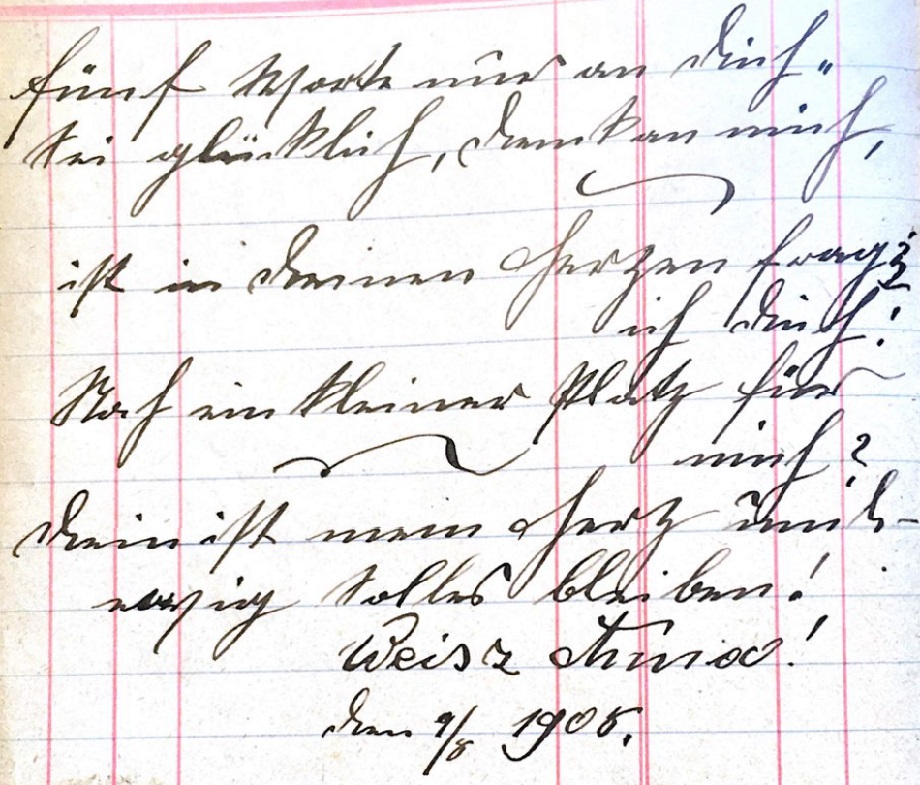|
The
|
||||||||||||||||
THE BURGENLAND BUNCH NEWS - No. 318 March 31, 2021, © 2021 by The Burgenland Bunch All rights reserved. Permission to copy excerpts granted if credit is provided. Editor: Thomas Steichen (email: tj.steichen@comcast.net) BB Home Page: the-burgenland-bunch.org BB Newsletter Archives: BB Newsletter BB Facebook Page: TheBurgenlandBunchOFFICIAL Our 25th year! The Burgenland Bunch Newsletter is issued monthly online. The BB was founded in 1997 by Gerald Berghold, who died in August 2008. |
||||||||||||||||
| Current Status Of The BB: * Members: 3037 * Surname Entries: 8974 * Query Board Entries: 5861 * Staff Members: 13 |
||||||||||||||||
This newsletter concerns: 1) THE PRESIDENT'S CORNER 2) GETTING TO KNOW ANNA LAURA (by Louise Suppan Bugbee) 3) HISTORICAL BB NEWSLETTER ARTICLES: - RESETTLEMENT OF WEST HUNGARY, POST-1700 4) ETHNIC EVENTS 5) BURGENLAND EMIGRANT OBITUARIES (courtesy of Bob Strauch) |
||||||||||||||||
1) THE PRESIDENT'S CORNER (by Tom Steichen)  Still
wearing my mask... hope you are too! (and I've had both vaccine doses!) Still
wearing my mask... hope you are too! (and I've had both vaccine doses!)This month's bits and pieces (Article 1) contains a video about the opening of Burgenland's "Our Americans" exhibition, an interesting animated graph of where US citizens emigrate to, and a monthly update on corona-virus happenings in Burgenland, plus our regular tidbit features, the monthly BB Facebook report, book sales and a words-for-thought item... we even throw in a recipe (that is related to Article 2!). Article 2, itself, is about Louise Suppan Bugbee's efforts to learn more about her grandmother, Anna Laura Weiss, a 115-year-old "tattered journal" written in the old German Kurrent handscript, and the BB's help in translating those pages. Along the way, Louise discovered she was Getting to Know Anna Laura better than she ever expected. The remaining articles are our standard sections: Historical Newsletter Articles, (no) Ethnic Events and Emigrant Obituaries. "Our Americans" Exhibition Opens Virtually: The 100th Anniversary Year special exhibition in the Burgenland State Museum in Eisenstadt, about Burgenland emigrants to America, opened virtually on the internet late last month, shortly after the Landesmuseum announced that in-person visits to the museum had been shut down due to rising Covid numbers. A 32-minute YouTube video (embedded below) was released to describe the exhibition and its origins. Though most of it is presented in German, there are short sections in English. Astrid Eisenkopf, a former Burgenland state councilor who now is Vice Governor of Burgenland and who visited the US as part of a Burgenland government delegation visit some years ago, is interviewed, as is the exhibition curator and state museum director, Gert Polster. In addition, Chargé d'Affaires, Robin Dunnigan, the current highest representative of the American Embassy in Austria (because President Biden has yet to appoint a new Ambassador to Austria), provides an English-language video message of greeting and congratulations. The opening is hosted by Alfons Haider, an Austrian actor, television personality and cabaret artist. The exhibition, itself, tells the life stories of 63 people from Burgenland who emigrated to America. Emigrations of US Citizens, 1978 to 2020: The following YouTube video is interesting in that it reverses the usual discussion about immigrants coming to the USA. Instead, it track the countries to which US citizens are emigrating. The first thing you should note is that the animation starts in 1978 when less than 600,000 US citizens are abroad. Over 42 years, that count rises to just under 3,000,000, which is still small relative to our total population... or in comparison to the number of immigrants coming to the US (over 30,000,000 during that same period). The second thing you should notice is that the longest bar remains a constant length, so we are seeing relative changes compared to that most-frequent destination. Given the total number of emigrants rises, the scale also adjusts. In addition, countries change vertical position, with the more-frequent destinations above the less-frequent ones. I'm not going to suggest an interpretation for these changes, as I'm sure you can do that for yourself. I will note that the animation runs slower than I'd prefer, as it spends quite a bit of time within each year. Also, there is no spoken narrative, so no need for sound. Anyway, have a look... and comment if you wish! If interested, here is a link to a similar animation for immigrants to the USA. It covers more years but functions the same way. There is also a second animated chart in that video that shows which countries sent the most immigrants to the USA for year 2019.  Corona
Virus in Burgenland: It's been an interesting month in Burgenland relative to Covid-19. Corona
Virus in Burgenland: It's been an interesting month in Burgenland relative to Covid-19. There was a scare in the town of Eisenstadt about a sudden (but false) rise in positive tests to a level that would have forced increased restrictions in and isolation of the town. In fact, though, there proved to be no such rise, rather, the testing laboratories had a batch of incompletely labeled test tubes so they assigned them to their default (symbolic) address for Burgenland, that being Eisenstadt. Everyone sighed in relief when the issue was understood. Then there was concern in Europe that the AstraZeneca vaccine was causing blood clots, which resulted in a related concern in Burgenland about whether that vaccine was part of the ongoing "vaccination schedule" for Burgenland citizens. In fact, all available supplies of the AstraZeneca vaccine had been used up in a recently completed campaign to vaccinate employees in the education system, so none was planned to be used in the near future for the main "vaccination schedule." However, Burgenland did not announce any change to the "schedule," so people assumed some of them were going to be given a vaccine (AstraZeneca's) that other countries were temporarily excluding. All was quickly explained but politicians still called for greater clarity. Then issues arose as Burgenland announced it was entering Phase 2 of vaccinations, a phase that purportedly gave priority to citizens age 65 and up. Immediately after, however, the Health Ministry announced the Phase 1b was not yet fully complete so any remaining "high-risk patients - regardless of age" and "the rest of the people who work in the health sector" and "people with disabilities" would all be slotted in before people between the ages of 65 and 79... so confusion reigned again for a while. Mid-month, Burgenland also announced a two-week availability of 50,000 free antibody tests that could be had along with a scheduled antigen test. While the antigen test indicates whether you have a current Covid infection, the antibody test indicates whether you had a prior infection strong enough to develop resistance against the virus. Apparently about half those getting the antigen test are also opting for the antibody test. This effort has apparently not created undue angst among the population! Then there was an article about the difficulties suppliers to Burgenland's many large thermo-bath hotels are suffering. The bath hotels, called "a driving force in the Burgenland economy," have been shut down for at least seven of the previous 12 months, with no concrete plans for a new reopening. This has placed their regionally-based suppliers of dairy products, fruits and meats in severe distress, as now-excess production must be dumped and costs to maintain livestock is eating into their remaining reserves; many are about to go under. Even the hotels are feeling the stress of maintaining properties that produce no income... but there seem to be no answers so far. On the 24th, a summit of the governors of the three eastern Austrian provinces, Burgenland, Lower Austria and Vienna, with the Austrian federal Health Minister was held to consider uniformly tightening restrictions, as cases of the more infectious and more aggressive British virus variant are rising rapidly there and intensive-care beds are in short supply, especially in Vienna (Burgenland's bed-utilization rate is over 75%). The result of the meeting is that Vienna, Lower Austria and Burgenland will go into a short lockdown over Easter, from April 1 through April 6... but epidemiologists are already assuming the region "will seamlessly transition into a longer one and spend April in lockdown." [In fact, two days after I wrote this paragraph, Vienna announced that it wants to extend their lockdown to at least April 11th... Burgenland and Lower Austria are saying they don't want to decide yet.] With the exception of daily necessities, all trade will be closed during the initial lockdown, including personal service providers such as hairdressers. "Access" testing will be required in the weeks thereafter. What that means is that there will be a further tightening of border controls and an a obligation to test twice a week for cross-border commuters. The schools will also switch to distance learning in the week after Easter. As in previous lockdowns, exceptions are allowed for walking or doing individual sports, looking after people in need and averting dangers. In additional news of note, Burgenland's Landesmuseum has shut down access to its displays at least through the month of March. Last month, I made the rather rosy statement that "...Burgenland expects the vaccination program to lead to a normalization of behavior by summertime, meaning we may have the opportunity to visit and participate in the 100th anniversary events that are held later this year." But things do not seem quite so rosy this month. 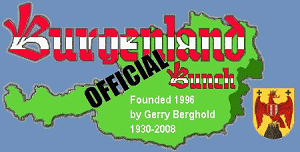 The
Facebook Bunch (from Vanessa Sandhu): The
Facebook Bunch (from Vanessa Sandhu):Greetings Burgenland Bunch! I hope that you are all doing well! Spring has finally sprung! Our little group is growing like a bunch of daffodils! We now have 1,604 members, which is an increase of 44 since last month. Please join us if you haven’t done so. We have many extremely helpful members who all love to help. We’d love to have you! www.facebook.com/groups/TheBurgenlandBunchOFFICIAL/ Admin Rachael Dobšovicová shared a great link with the group: Burgenland Then and Now: It features photos of many Burgenland villages 100 years ago with side-by-side images of them today. You can scroll down to the bottom to see the list of individual places included. In the upper right corner, click on the three lines and choose Storymap, where you can see photos by region. Histories and links are also given, but in German. burgenland100.weebly.com/zeitspruenge Member Tim Stein shared another interesting link from Landesmuseum Burgenland that features the opening of their “Unsere Amerikaner” (Our Americans) exhibit. The exhibit showcases the biographies of 63 Burgenland emigrants. Portions are in English, but the majority of the presentation is in German. youtube.com/watch Member Gerhard Lang shared a lovely video from YouTube entitled “Schönes Burgenland” by Franz Göltl: youtube.com/watchfeature Member Ingrid Schuster’s Gedmatch "Burgenland Bunch Ancestor" project now has 174 total kits. Great work, Ingrid! Many of us have connected with distant cousins through your hard work! CONNECTIONS: New member Claudia Nur Ganz Kurz is searching for Bugnitz family members who settled in Northampton, Pennsylvania or New York. Member Gregory Klepeis is searching for others researching the Klepeis family from Strem. Member Glenn Sigsby Is searching for information on his maternal grandmother, Maria (Vertesich) Nemeth, who lived in Kroatisch Geresdorf at street address, "Kleine Zeile 10", before coming to South Bend, Indiana. Any additional information anyone could provide would be greatly appreciated. If anyone would like to contact Claudia, Gregory, or Glenn, please let me know and I’d be happy to relay any information to them. My email address is HooftyRN@msn.com. Have a great week. Take care and stay safe and healthy! Vanessa  Update
for book "The Burgenländer Emigration to America": Here is this month's update on purchases of the English issue of
the 3rd edition of Dr. Walter Dujmovits' book "Die Amerika-Wanderung Der Burgenländer." Update
for book "The Burgenländer Emigration to America": Here is this month's update on purchases of the English issue of
the 3rd edition of Dr. Walter Dujmovits' book "Die Amerika-Wanderung Der Burgenländer."Current total sales are 1592 copies, as interested people purchased 13 more books during this past month. As always, the book remains available for online purchase at a list price of $7.41 (which is the production charge for the book, as we purposely choose not to make a profit so we can avoid dealing with the income tax consequences and so you can obtain the book at as low a cost as possible!), plus tax & shipping. See the BB homepage for a link to the information / ordering page and for information about current discounts (there is at least one discount on price or shipping available most of the time... if not, wait a few days and there will be one!). Getting the book and reading it is an excellent way to pass the time during the coronavirus-imposed "house arrest." Burgenland Recipes: This recipe for Weichselschnitten (Sour Cherry Slices) comes to us in an extremely unusual way... so let me explain. Article 2 below, by Louise Suppan Bugbee, is about her grandmother, Anna Laura Weiss. As part of Louise's effort to learn more about Anna Laura, she both consulted her cousins and attempted to join the BB. One cousin sent her some postcards and a "tattered journal," all written in the old German Kurrent handscript... and that writing defeated her efforts to read them. Further, it turned out that the only connection Anna Laura had to Burgenland was that, from Vienna, she was "sent to a foster home in Mogersdorf" from ages 10 to 18. Nonetheless, we agreed to help Louise translate some of the cards and journal pages... and the first section of the journal proved to be recipes. The journal that provided these recipes was dated 1906, when Anna Laura would have been about 17 and, therefore, toward the end of the time she was in Mogersdorf, so it seems probable that the recipes are likely more of Burgenland origin than anywhere else. Below we give you the complete transcribed German text of a recipe for "Sour Cherry Slices," followed by a translation of that text, including a translation of the quantities originally given in weight units (usually dekagrams, indicated as "dk") to the corresponding volume units used in the USA. [If you would like to see the original text of the recipe in more detail, click the thumbnail image of it below.] However, if you look at the translation, you will see that it is quite short on "assembly" instructions and does not include a baking temperature, so Louise had to experiment and develop a functional revised recipe. We present that revised recipe as the third section below. Weichselschnitten (by Anna Laura Weiss) 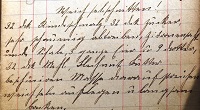 32 dk Rindschmalz 32 dk Rindschmalz32 dk Zucker sehr schaumig abtreiben Zitronensaft und Schale 3 gange Eier und 9 dotter 32 dk Mehl Blech mit Butter beschmieren Masse daraufstreichen Weichseln auflegen und langsam backen.  Sour
Cherry Slices (translated) Sour
Cherry Slices (translated)32 dk beef lard (= 1.4 cups) 32 dk sugar (= 1.6 cups) blend very frothy Lemon juice and peel (zest) 3 whole eggs and 9 yolks 32 dk flour (= 3 cups) Smear the tray (baking sheet/pan) with butter Wipe the mass (mixture) on top, put on sour cherries and bake slowly. Revised Sour Cherry Slices (adaptation by Louise Suppan Bugbee) 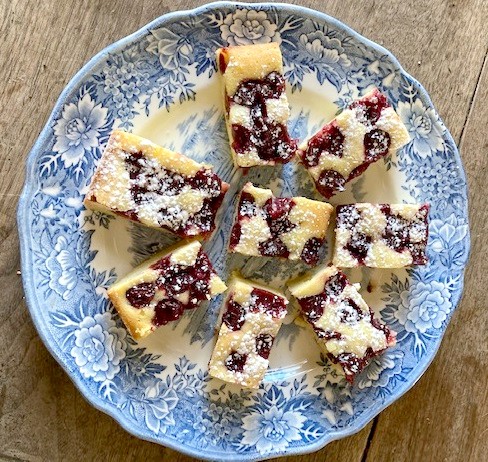 It
is sort of a dense pound cake bottom with the cherries on top. It
is sort of a dense pound cake bottom with the cherries on top.Instead of lard, I used butter, and I made a half-recipe. Tasty. Definitely better with the butter. Lard was much cheaper than butter, so I think that is why so many of the recipes use it. 10 tbs. butter ¾ cup sugar 2 whole eggs and 4 yolks 1½ cups flour ¼ tsp salt Juice and zest of one lemon Pitted sour cherries, 24 oz. jar, drained - Butter a 10" square pan. Line the bottom with parchment. - Preheat oven to 325 degrees. - Cream butter and sugar until light and fluffy. - Add eggs and yolks, beat well. - Mix flour with salt and add in slowly, alternating with lemon juice and zest. - Spread mixture in pan, top with the cherries in one layer. - Bake about 45-50 minutes until golden brown. - When cool, sprinkle with powdered sugar. Cut into squares.  Note:
We have updated the recipes sortable list with links directly to the recipes or food-related
articles published in our past newsletters. You can access the list by clicking our recipe box (to the right). Thanks to the
contributions of our members over the years, we have quite a collection of Burgenland recipes, some with several variations. Note:
We have updated the recipes sortable list with links directly to the recipes or food-related
articles published in our past newsletters. You can access the list by clicking our recipe box (to the right). Thanks to the
contributions of our members over the years, we have quite a collection of Burgenland recipes, some with several variations.However, we have now used up most of our unpublished recipes... thus this recipe section will become dormant when we run out. So, if you have a favorite family recipe, please consider sharing it with us. We will be happy to publish it. Our older relatives, sadly, aren't with us forever, so don't allow your favorite ethnic dish to be lost to future generations. You can send your recipe to BB Recipes Editor, Alan Varga. Thanks! Words for Thought: "Misers aren't fun to live with, but they make wonderful ancestors." — comedian David Brenner |
||||||||||||||||
2) GETTING TO KNOW ANNA LAURA (by Louise Suppan Bugbee) — How a 115-year-old journal led me to the Burgenland Bunch — 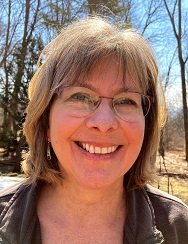 Anna Laura Weiss was my grandmother, the Nana I only remember as a dying woman on a high bed. She died in 1958,
when I was three. My mother and I rode the bus every day from Catasauqua to Allentown, Pennsylvania, to care for her. Anna Laura Weiss was my grandmother, the Nana I only remember as a dying woman on a high bed. She died in 1958,
when I was three. My mother and I rode the bus every day from Catasauqua to Allentown, Pennsylvania, to care for her.
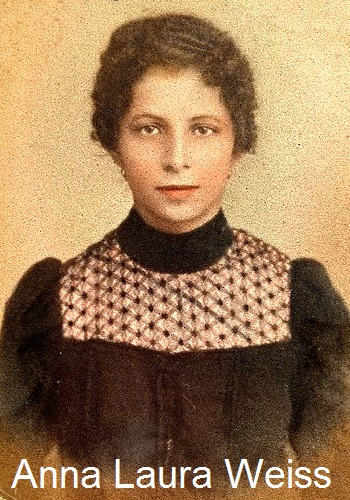 My
older sisters and cousins have fond memories of Nana baking kiffles and strudels, telling silly jokes,
gardening and tending chickens in the yard on Railroad Street in Allentown. I found my Anna Laura last year with the help of
Burgenländers Tom Steichen and Willi Schmidt. My
older sisters and cousins have fond memories of Nana baking kiffles and strudels, telling silly jokes,
gardening and tending chickens in the yard on Railroad Street in Allentown. I found my Anna Laura last year with the help of
Burgenländers Tom Steichen and Willi Schmidt. It began when, locked in by COVID, I decided to finally take a grad course in what I always wanted to pursue but never did, Children’s Literature. In lieu of a big final research paper, I accepted a challenge to produce a novel—a middle-grade chapter book—in one month. The stories I had heard from my mom, sisters, aunts and cousins about Nana seemed like a great place to start. Anna Laura was born in Vienna in 1889. What we knew was that she was an illegitimate child of a Viennese mother and a Jewish father who abandoned them. At the age of 10, she was sent to a foster home in Mogersdorf to work as a housemaid and there she stayed until the age of 18. 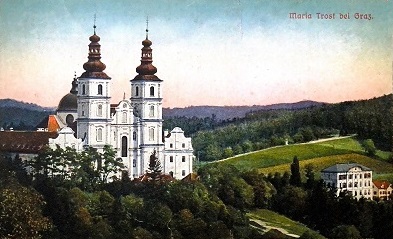 Her
mother later married and bore a half-sister named Josephine, known as Aunt Pepi. Pepi married a Croatian man
and they also came to America, eventually settling in the Catskills. Her
mother later married and bore a half-sister named Josephine, known as Aunt Pepi. Pepi married a Croatian man
and they also came to America, eventually settling in the Catskills.[Postcard to right: Pepi's Wedding Church, Maria Trost bei Graz. Click image to access a larger version of this image and also an image and translation of the message on the other side of the card.] By all accounts, Anna Laura was feisty and opinionated. It was easy to believe my Aunt Ella’s tale about her being a union organizer at the factory in Hungary where she found work as a teenager. It was during an uprising that she was apprehended by Rudolph Kornfeld, a mounted Hungarian gendarme who was called in to quell the riot. Fortunately for Anna Laura, Rudolph knew her foster father and took her home. 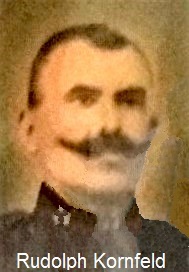 Rudolph
was born in Beremend, Hungary, in 1877. He was accepted into the Academy and became a Royal Hungarian Gendarme,
a mounted policeman. At that time, Austria and Hungary were part of the Austro-Hungarian Empire ruled by Franz Josef, though
Hungary had some autonomy. It was largely agricultural, and the Royal Gendarmerie were responsible for keeping peace
in the villages and countryside. Rudolph
was born in Beremend, Hungary, in 1877. He was accepted into the Academy and became a Royal Hungarian Gendarme,
a mounted policeman. At that time, Austria and Hungary were part of the Austro-Hungarian Empire ruled by Franz Josef, though
Hungary had some autonomy. It was largely agricultural, and the Royal Gendarmerie were responsible for keeping peace
in the villages and countryside.Anna Laura and Rudolph later emigrated to Allentown and married in 1909. It was their story I wanted to tell. Regrettably, my mother and her three sisters are all gone. I realized too late that I did not ask enough questions. Part of my goal in writing this for middle-grade students is to instill a curiosity in them to find out about their own heritage, to get their stories before it is too late. Our personal histories are just as fascinating as any fiction. I resorted to family interviews, prying into the brains of my sisters and cousins. It was illuminating to hear the different versions of their Nana memories. Then, in what was the best thing ever to come from California through the US Mail, my cousin Stef sent a package of several postcards and what appeared to be a tattered journal. I could tell it was written in German, but I could not understand a word. I showed it to several German speakers and learned it was old Kurrent handscript, but they were unable to pick out more than a few words. And that is when I found the Burgenland Bunch! From a random internet search, Tom Steichen and Willi Schmidt of the BB became my saviors! I contacted Tom and he informed me gently that birth in Vienna and working in Mogersdorf did not qualify as Burgenland ancestry. Even my father’s family, who emigrated from Graz, Austria, did not make the cut! I officially had no BB: no Burgenland Blood! But he and Willi very generously agreed to take a look at my documents. Tom, Willi and I went back and forth for a few weeks before I finally asked where they lived. And guess what? We are all in Pennsylvania and Willi lives only about 10 miles away from me! And, he went to high school in Allentown with my sister. The ragged first page of the journal read, “Anna Weiss on July 20th 1906 Mogersdorf Hungary.” I scanned and emailed them some pages. 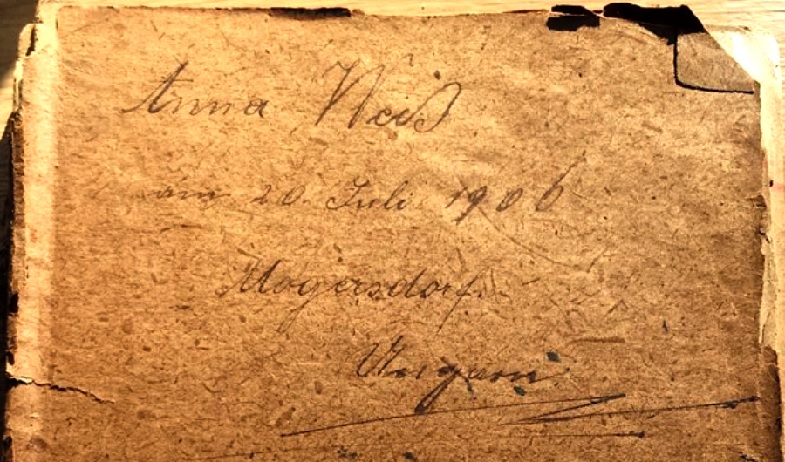 The first pages turned out to be a lot of recipes. [Ed: an example recipe is given in our Burgenland Recipes section above.] But then, because I didn’t want them to get bored with translating humble recipes for cherry slices and raspberry sauce, I scanned what looked like verses where I could make out the name of Rudolph. There, in her beautifully hand-written script, my 17-year-old grandmother had poured out her love and soul. The first verse (image here) read:
The professions of affection continued. She was clearly smitten with him.
Each time I sent a scan I was so thrilled to see that Tom and Willi had translated it so quickly. Some of verses (here)
can be directly linked to what I know about Anna Laura and Rudolph. He was 12 years older than she and, in some of the
verses, it is quite evident that she is aware of his previous alliances. She refers to it as him having a “dappled heart."
And how heartbreaking to give a beggar woman a penny to cry for her. These translations are a priceless gift, a chance
for me to feel close to these two people I never knew but whose blood flows through my veins. Suddenly, they became real.
They were not just grandparents who died long ago. They had lives and stories, they had been through troubled times and
persevered. They gave life to my mother, and so, to me.
|
||||||||||||||||
3) HISTORICAL BB NEWSLETTER ARTICLES Editor: This is part of our series designed to recycle interesting articles from the BB Newsletters of past years. The entry below is the first part of an article from 10 years ago, an article that is quite long but also, in my mind, quite important. Given its length, I've chosen to include below only the "set up" from the article, the part showing what the question was and how we will attack it. For the rest of the article, I'm just going to include a link back to the originating newsletter... you can read it there as easily as here! THE BURGENLAND BUNCH NEWS No. 208 March 31, 2011 RESETTLEMENT OF WEST HUNGARY, POST-1700 The Burgenland has a long history of being frontier country. Even up to quite recent times, its eastern border was part of the "iron curtain" defining the frontier separating Eastern and Western Europe. As a result, Burgenland has a history of being a mixing pot of ethnicities, religions and societies. During much of the 16th and 17th centuries, the Ottoman Turks occupied central and southern Hungary, using it as a staging ground on its assaults on Vienna and Middle Europe. Western Hungary became a battle ground where armies clashed; Burgenland itself was behind the temporary front lines when the Turks twice set siege to Vienna. By the time the second siege was broken in 1683, 150 years of occupation and war had devastated and depopulated much of Hungary. These facts led Mary Reilly, the BB E-mail List Manager, to ask when and how Hungarian landowners recruited German settlers to repopulate Hungary, saying "I know they offered a "tax break" -- relieved of all taxes for 3 years, along with receiving land. I know that after the Turkish occupation and the plague epidemic, Hungary's population was down... Do you know anything about this?" Well, it was not a topic I knew much about... but it did seem worth investigating... so I invited the BB Staff to report whatever they knew about the subject, especially as it pertained to the region of West Hungary that became Burgenland, promising also to dig into the topic myself. To give the effort direction, I stated a number of questions: 1) What were the facts on Hungarian population size changes around 1700? 2) When did the recruitment start? 3) How was the actual recruitment done? 4) What were the incentives that were offered? 5) Why German settlers (rather than other ethnicities, in particularly Hungarian)? 6) How did the post-1700 influx differ from the earlier Croatian migrations that Frank Paukowits had recently written about? 7) What historical documents exist concerning the recruitment and its effects? Interestingly, although the Staff responded as they always do, I was slightly frustrated because the responses either targeted an earlier period or tended to speak of resettlements in central, eastern and southern Hungary. The references I found in my own research were also off target temporally or location-wise. 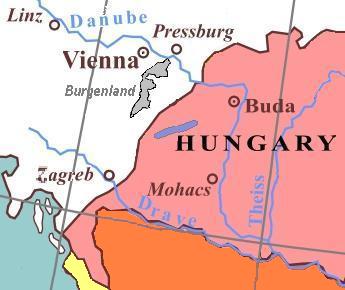 So
why was this true? The simple answer is that the main thesis of the question, when directed specifically at Burgenland, was
wrong! Burgenland, as a whole, was never extensively occupied nor largely depopulated... yes, armies marched (or fled)
through it, but the duration behind the Ottoman military line was measured in months—not the 150 years that most of Hungary
endured. One can assume that villagers, who could, fled ahead of the Ottoman army... but they almost certainly returned
shortly after the Habsburgs and allies drove the Turks back. So
why was this true? The simple answer is that the main thesis of the question, when directed specifically at Burgenland, was
wrong! Burgenland, as a whole, was never extensively occupied nor largely depopulated... yes, armies marched (or fled)
through it, but the duration behind the Ottoman military line was measured in months—not the 150 years that most of Hungary
endured. One can assume that villagers, who could, fled ahead of the Ottoman army... but they almost certainly returned
shortly after the Habsburgs and allies drove the Turks back.The map below... End of excerpt, go here for the full article: Newsletter208.htm#08. |
||||||||||||||||
4) ETHNIC EVENTS (none! ...blame the virus!) LEHIGH VALLEY, PA (none) NEW BRITAIN, CT (none) ST. LOUIS, MO (none) UPPER MIDWEST (none) |
||||||||||||||||
5) BURGENLAND EMIGRANT OBITUARIES Marie Clement (née Schleder)  Marie (Schleder) Clement, 89, of
Guilderland, New York, passed away peacefully at home on Sunday, March 21, 2021, surrounded by her loving husband and
daughter. Marie (Schleder) Clement, 89, of
Guilderland, New York, passed away peacefully at home on Sunday, March 21, 2021, surrounded by her loving husband and
daughter.She was married to Warren H. Clement, and they were happily together for 51 years. Born in Troy, NY, and raised in Langzeil, Austria, she was the daughter of the late John and Bertha (Dukowitz) Schlederer. In 1922, Marie’s parents came to the U.S. to seek employment. Twelve years later when Marie was 2 years old, she and her family moved back to Austria where her parents purchased their family farm. She grew up in Austria during the second World War. In 1953 Marie would return to the U.S. where she would live in Troy and Albany, NY before settling in Guilderland, NY. She was devoted to her family and would proudly state Teddy was her favorite. An excellent cook, “Grandma’s Cookies” were well known by many. With her natural talent, she was employed in the food service industry for her entire working career. She managed cafeterias, coffee shops, and worked in several area restaurants. She enjoyed raising her large vegetable garden and shared the produce with family members and neighbors. She is survived by her husband Warren, her daughter Anna Marie (Mitchell) Kupinski, grandson Justin (Alisa) Kupinski, great-grandson Theodore, several nieces and nephews, as well as many close friends. She is predeceased by her parents, Bertha and John, her sister Margaret, her brothers; John, Frank and Edmund, and her grandson Jason Kupinski. Calling hours will be held on Thursday, March 25, 2021 from 5pm-7pm at the DeMarco-Stone Funeral Home, 5216 Western Turnpike, Guilderland, NY 12084. A Mass of Christian burial will take place at 10am on Friday, March 26 at St. Madeleine Sophie Church, 3500 Carman Rd., Schenectady, NY 12303. Please note that masks will be required to enter both the church and funeral home. Published by Albany Times Union on Mar. 24, 2021 Mary Holecz (née Kranyecz)  Mary Holecz, 87, of Douglassville,
Pennsylvania (formerly of Allentown) passed away peacefully on Friday, March 5, 2021. Mary Holecz, 87, of Douglassville,
Pennsylvania (formerly of Allentown) passed away peacefully on Friday, March 5, 2021.Born in Rábatótfalu (Slovenska Ves/Windischdorf), Hungary, to the late Istvan and Terezia (Doncsecs) Kranyecz, Mary immigrated to Bethlehem with her sister Theresa, following the 1956 Hungarian Revolution. There she met her future husband of 60 years, Joseph, a fellow Hungarian immigrant. Before settling down and raising two sons in the South Mountain section of Allentown, Mary worked as a seamstress for various knitting mills throughout the ABE area. Throughout her life, sewing remained a passion. Her skills were second to none, she could make or fix anything. Even while in Hospice, Mary inquired about the state of her beloved Singer sewing machine. Retirement was filled with gardening and enjoying her grandchildren. Mary lived in Allentown until the death of her husband, then moved to Douglassville to be closer to her son and grandchildren. This enabled her to attend various school functions and family events. Always a smile on her face, her kind and gentle demeanor will forever be missed. Mary is survived by her son: David and his wife: Lisa, and two grandchildren: Zachary and Emily (Pottstown); sister: Anna Sömenek (Hungary); brothers: Laszlo, Ferenc (both of Hungary) and Joseph (Switzerland). Mary was preceded in death by her husband: Joseph; her son: Joseph Jr.; mother and father: Terezia (Doncsecs) and Istvan Kranyecz (Hungary); sister: Theresa Treiber (Bethlehem); and brother: Istvan (Switzerland). Services: Giving respect to our family and friends during this pandemic, a 'Celebration of Life' for Mary will be held later this spring/summer. Condolences can be made on the Weber Funeral Home website: https://www.weberfuneralhomes.com. In lieu of flowers, donations can be made to 'Autism Speaks': https://www.autismspeaks.org Published in Morning Call on Mar. 21, 2021 Joseph Wagner  Joseph Wagner, 93, of Moore Township,
Pennsylvania, passed away on Thursday, March 04, 2021, at St. Luke's Hospital – Anderson Campus in Bethlehem Township. Joseph Wagner, 93, of Moore Township,
Pennsylvania, passed away on Thursday, March 04, 2021, at St. Luke's Hospital – Anderson Campus in Bethlehem Township.He was the husband of Nadine C. (Trach) Wagner. They would have celebrated their 25th wedding anniversary on June 8th. Born in Poppendorf, Austria, he was a son of the late Rudolf and Juliana (Garger) Wagner. After serving in the military during World War II, he became an apprentice butcher and subsequently immigrated to the United States, where he became a proud citizen. For many years, Joe owned and operated Wagner's Market in Carmel, New York, with his first wife, Hilda. He was of the Catholic faith. Joe enjoyed off-track betting, sports, dancing at the Austrian Club, travel, mowing his yard, gardening, and cooking his special apples, vanilla kipferl and famous potato salad. Most importantly, he loved being with his family and friends at gatherings. Survivors: In addition to his loving wife, Nadine, he is survived by his daughters, Helga Artale and husband, Peter, of Franklin, Massachusetts, and Diane Carlson and husband, Charles, of New Fairfield, Connecticut; stepsons, Daniel Flood and wife, Ann, and David Flood and wife, Joy, both of Moore Township; five grandchildren, Daniel, Timothy, Jacob, Ella and Andrew; four great-grandchildren, Evelyn, Bridget, Aidan and Adaline; along with many nieces and nephews. Joe was predeceased by his first wife of 37 years, Hilda Wagner; a step-granddaughter, Lauren Flood; as well as his two brothers and four sisters. Services: Due to current restrictions, services will be announced at a later time when it is safe to gather. Arrangements have been entrusted to the GEORGE G. BENSING FUNERAL HOME, LLC, in the Village of Moorestown – Bath. Contributions: In lieu of flowers, memorial contributions may be offered to Lauren's Hope Foundation, 2157 W. Dell Road, Bath, PA 18014 or a charity of one's choice. Published in Morning Call on Mar. 14, 2021 Stella O'Brien (née Schlener)  Stella A. O’Brien, of Delmar, New
York, was together with family when she passed away on Saturday, February 27, 2021 at the age of 85. She is now in Heaven
reunited with her devoted husband James. Stella A. O’Brien, of Delmar, New
York, was together with family when she passed away on Saturday, February 27, 2021 at the age of 85. She is now in Heaven
reunited with her devoted husband James.Stella was the daughter of Josef and Gisela Schlener, born in Allentown, Pennsylvania, and raised in Poppendorf, Austria. Her life was interesting from the very beginning. After surviving WW-II as a little girl, she traveled daily from the Russian Zone to a British Zone where she attended school and was able to learn English. She was very active in theater, music, and took private typing classes. In 1951, visitors from the United States came to her house to bring a ring as a gift from her Godfather. They invited her to come to America since she was an American citizen. This became her miracle and with her parent’s permission she moved to the country that she came to love. Stella’s friendly, outgoing personality opened many doors for her in America. She had many wonderful and interesting employers, and worked for McGraw and Hill Publishing Company. She was a nanny and managed the household of a Naval Captain as well as a vascular surgeon. At age 19 she traveled to Europe to visit her parents. There she met the love of her life on the famous Orient Express train, a handsome gentleman in the Air Force, Dr. James P. O’Brien. After his discharge they got married and were blessed with 62 years of very happy marriage, as well as two wonderful children. Stella enjoyed travel to many places, including Italy, Spain, many other European countries, and several Island nations. She became a nurse and worked at Albany Medical Center Hospital while her beloved husband James went to medical school and became a neurosurgeon. Retiring when she became a mother, Stella spent many happy years with her family skiing, traveling, and enjoying life. She was a caring, loving supporting wife and mother. Wherever she went, Stella met many interesting people and had fascinating experiences. She made lifelong friends simply by sitting next to them on an airplane, was honored by an airline for being it’s 5000th passenger, leading to a surprise visit from Austrian politicians, the president of an Austrian-American organization, and a large brass band. She even was a winner on the television game show “I Guess”, hosted by Bill Cullen. Her kindness, generosity, honesty, and love of life combined with her deep Catholic beliefs to bring her much love and joy with her family, relatives, and friends. She was deeply grateful for those blessings. Stella is survived by her dearly beloved daughter, Heather O’Brien (Jim Smith), her step-granddaughters Rachel and Julianna Smith, and her step-great-grandson Grayson. She is also survived by her loving son Brendan O’Brien and her granddaughters Cassidy and Ella O’Brien, as well as many nieces and nephews, and cousins in Canada and Austria. Countless others saw her as a mother figure, including many who didn’t enjoy the loving family bonds she had, as she made sure to impart her love on those souls throughout her life. In addition to her parents and husband, Stella was also predeceased by her brothers, Julius and Josef Schlener. Relatives and friends are invited to call on Friday, March 5 from 4 to 7 pm at Applebee Funeral Home, 403 Kenwood Ave., Delmar. A funeral mass will be celebrated 10 am Saturday, March 6 at St. Thomas the Apostle Church, 35 Adams Pl., Delmar. Burial will be in St. Agnes Cemetery, Menands at a later date. In lieu of flowers, contributions may be made to Community Hospice, 310 So. Manning Blvd., Published by Albany Times Union from Mar. 2 to Mar. 4, 2021 Joseph Povacz  Joseph Povacz, 88, of Metuchen, New
Jersey, passed away on Saturday, February 27, 2021. Joseph Povacz, 88, of Metuchen, New
Jersey, passed away on Saturday, February 27, 2021.Born in Rechnitz, Austria, he resided in Metuchen since 1962. Joe was the most loving husband and father. He was predeceased by his wife of 67 years in December, Anne. He is survived by his three sons and their wives, Robert Povacz (Linda), Gerald Povacz (Carolyn), and Richard Povacz (Maria); four grandchildren, Arly, Gary, Christopher, and Erik; great-grandson, Alexander; sister, Mitzi Rowe; one niece, Karen, and two nephews, John and Peter, as well as an extended family in Austria and Switzerland. A private cremation will take place under the direction of the Costello-Runyon Funeral Home, Metuchen (www.costello-runyon.com). Published in Home News Tribune from Mar. 2 to Mar. 6, 2021 |
||||||||||||||||
| END OF NEWSLETTER (Even good things must end!) |
||||||||||||||||
|
Burgenland Bunch Newsletter, copyright © 2021 by The Burgenland Bunch |
||||||||||||||||
 News
News